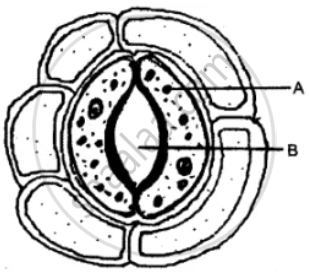Advertisements
Advertisements
प्रश्न
Given below are the diagrams of a certain structure in plants in two conditions.

(i) Name the structure shown.
(ii) Name the parts numbered 1-5.
(iii) What is the most apparent difference between A and B in the structure shown?
(iv) Describe the mechanism which brings about the change in the structure depicted in A and B.
उत्तर
(i) Stomata surrounded by epidermal cells.
(ii)
- Chloroplast,
- The inner wall of guard cells,
- Nucleus,
- Guard cells,
- Stoma.
(iii) The stoma is open in A and is almost closed in B.
(iv) The opening and dosing mechanism of stomata is regulated by the amount of water and solutes present in the guard cells. The guard cells have a thick inner wall facing the opening and a thin outer wall on the opposite side; their cytoplasm contains chloroplasts. During the day guard cells begin photosynthesis and the sugar produced during the process increases the osmotic pressure which draws in water from the adjoining cells. Hence, the guard cells become turgid and bulge outward due to their thin outer wall, thus widening the stomatal opening lying in between (A). As the stomata open, the diffusion of gases in and out begins to fulfilling the need for photosynthesis and for allowing transpiration. If for any reason the water content of the leaf is falling short, the guard cells fail to remain turgid, they turn flaccid or lose turgidity, thereby closing the stomatal opening (B) and the transpiration stops.
APPEARS IN
संबंधित प्रश्न
Given ahead is a diagram of an experimental setup to study the process of transpiration in plants. Study the same and then answer the question that follows:

- Name the colour of dry cobalt chloride paper.
- Is the experimental leaf a monocot or a dicot? Give a reason to support your answer.
- Why are glass slides placed over the dry cobalt chloride papers?
- After about half an hour, what change, if any, would you expect to find in the cobalt chloride paper placed on the dorsal and ventral sides of the leaf? Give a reason to support your answer.
Give Reasons for the following:
Guard cells are small in size and are kidney-shaped in outline.
Differentiate Between Stomata and Hydathodes.
The diagram below represents a structure found in a leaf.

Study the same and answer the questions that follow:
(i) Name the pis labeled A and B.
(ii) What is the biological term for the above structure?
(iii) What is the function of the part labeled A?
(iv) Mention two structural features of A, which help in the function mentioned in (iii) above.
(v) Where is this structure likely to be found in a leaf?
(vi) The above structure helps in the process of transpiration. Explain the term transpiration.
(vii) How many other cells are found surrounding this structure as seen in the diagram?
Name the following:
A plant having sunken stomata.
Name the following:
The openings on the barks of trees through which transpiration occurs.
Name the three kinds of transpiration.
Give a reason/suitable explanation.
Leaves of some plants wilt during midday and recover in the evening.
